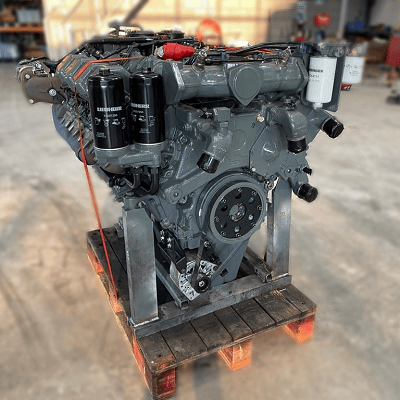The process of a dyno test on a Liebherr engine

When it comes to heavy machinery, reliability and power are paramount. Liebherr, a name synonymous with innovation and excellence in engineering, stands tall as a pioneer in the realm of heavy equipment and machinery. From towering cranes to robust excavators, Liebherr’s engineering prowess extends to the heart of these machines. We delve into the world of dyno testing a Liebherr engine, uncovering the meticulous process behind unleashing the raw power concealed within.
The foundation of excellence
Before we embark on the journey of dyno testing, it’s crucial to understand the foundation upon which Liebherr engines are built. With decades of engineering expertise and commitment to quality, Liebherr engines are crafted to withstand the most demanding environment and deliver unparalleled performance. Each component is meticulously designed and rigorously tested to ensure reliability, efficiency and longevity.
The process
1 Preparation: The engine undergoes meticulous preparation before being mounted onto the dynamo meter. This includes ensuring all connections are secure, fluids are filled to the appropriate levels, and sensors are properly calibrated.
2 Mounting: The engine is carefully mounted onto the dynamometer, a specialized device designed to simulate real-world operating conditions. Precision is paramount during this step to ensure accurate results.
3 Initial checks: Once mounted, a series of initial checks are conducted to verify proper alignment, connection integrity, and functionality of all engine systems.
4 Warm-up: The engine is started and allowed to warm up to operating temperature. This ensures consistent results and minimizes the risk of damage during testing.
5 Baseline testing: With the engine warmed up , baseline tests are conducted to establish initial performance metrics. This includes measuring power output, torque, fuel consumption, and emissions at various RPM levels.
6 Load testing: The engine is subjected to progressively increasing loads to simulate different operating conditions, such as idle, partial load and full load. This allows engineers to assess performance across the entire operating range and identify any potential issues or optimization.
7 Data analysis: Throughout the testing process, data is continuously collected and analyzed in real-time. Advanced instrumentation and software are used to monitor performance metrics and identify trends or anomalies.
8 Optimazation: Based on the data analysis, adjustments may be made to optimize engine performance. This could involve fine-tuning fuel injection timing, adjusting air-fuel ratios, or optimize turbocharger boost pressure.
9 Validation: Once testing is complete, the results are meticulously reviewed and validated against predetermined criteria and specifications. Any deviations or anomalies are thoroughly investigated to ensure accuracy and reliability.
10 Reporting: Finally, a comprehensive report is generated detailing the results of the dyno testing, including performance metrics, observations, and any recommendations for further optimization or refinement.
The outcome of dyno testing
Dyno testing a Liebherr engine is more than just a routine procedure – it’s a testament to the unwavering commitment to excellence that defines Liebherr’s engineering philosophy. By subjecting their engines to rigorous testing and analysis, Liebherr ensures that each engine delivers the uncompromising performance, reliability, and efficiency that customers expect.
In conclusion, dyno testing a Liebherr engine is not just about measuring power output. It’s about unlocking the true potential of these remarkable engines and ensuring they exceed expectations in the most challenging environments imaginable.
Product Description
The water and air dual purpose series drilling rig is a multifunctional drilling rig that integrates water and air drills. This is the first one in China. The drilling rig adopts an AMT manual automatic transmission. Sensitive and convenient switching between positive and negative. Compared with hydraulic transmission, the power consumption is reduced by 35%, making it more efficient and energy-saving. The drilling rig has a fast speed and can be used in conjunction with a Mud Pump to solve the problem of difficult drilling with a soil gas down-hole hammer. The boring machine has high torque and can slide up and down. Deep hole drilling can be used for hard rock layers, gravel layers, and pebble layers below deep wells. Drill with a down-hole hammer. This drilling rig can be professionally engaged in drilling, monitoring wells, geothermal air conditioning drilling, diamond bit wired coring drilling, and engineering geological survey operations.
The main characteristics of the drilling rig:
1. The drilling rig is equipped with a hydraulic drill tower, hydraulic support legs, and a winch, and the power head can slide up and down. Hard rock can be used for DTH hammer drilling.
2. The drilling rig adopts a long stroke dual speed mechanism and mechanical power head, with a power head stroke of 3400mm, which is used to improve drilling efficiency and reduce the occurrence of blockage and burning accidents.
3. The drilling rig adopts dual oil pumps for oil supply. When feeding, a single pump is used, and when lifting the drill pipe, a dual pump combination is used; Low power loss and short auxiliary time.
4. The drilling rig has reserved some functional interfaces in the hydraulic system, which can be expanded according to the process requirements of different users.
Mutifunction Drilling Machine,Multi Purpose Drilling Rig,Multi Function Drilling Machine,Multipurpose Drilling Rig
JIANGSU XI TEC ENVIRONMENTAL&DRILLING EQUIPMENT COMPANY CO.LTD , https://www.xitecdrillingwx.com